Garum: The Unami of Ancient Rome
What made garum, a type of fermented fish sauce, so extremely popular across the Roman Empire?
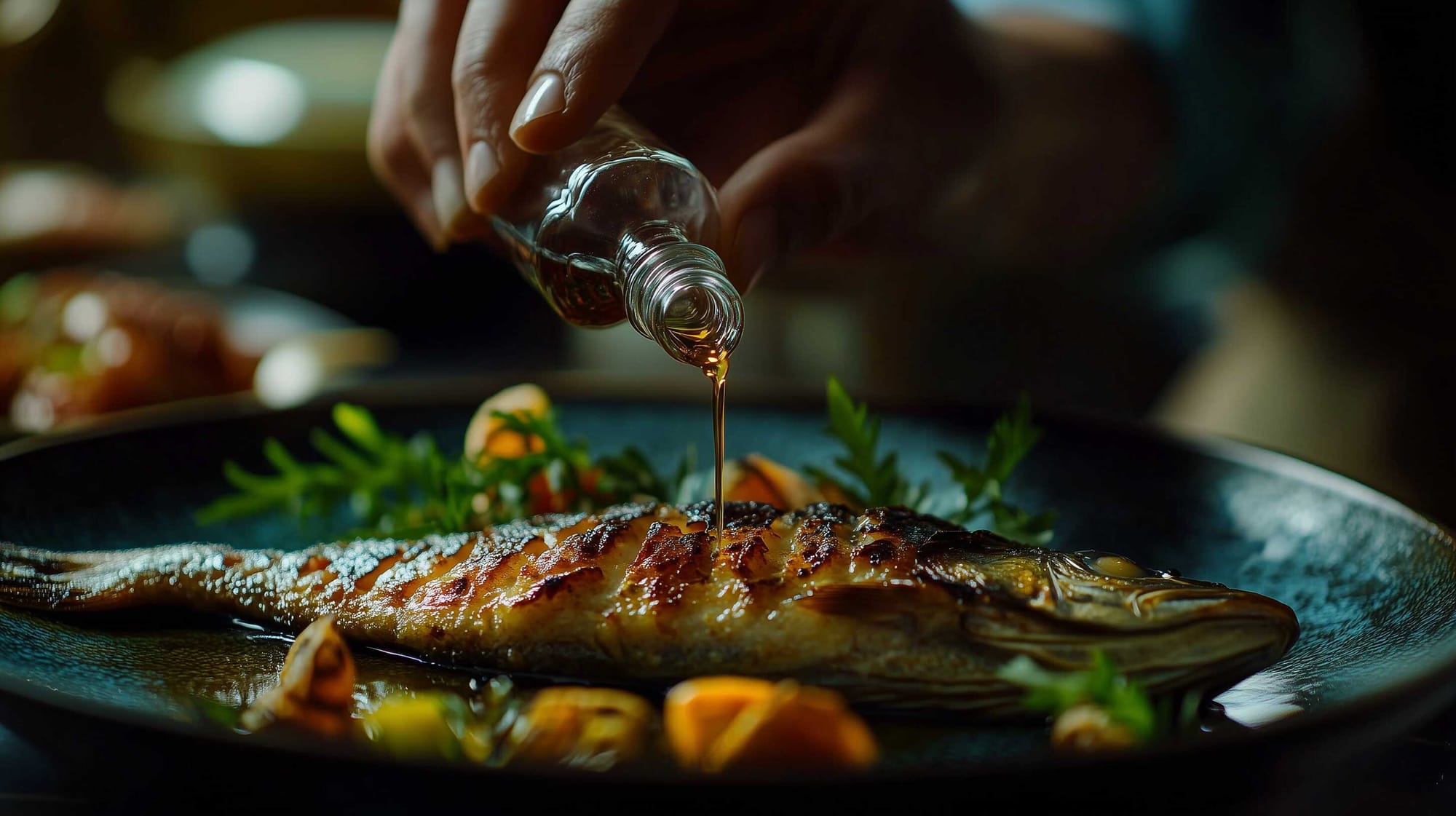
Garum was once a not-so good smelling fish paste made by the Greeks, that later became an expensive delicacy of the Roman Empire. The Romans went the extra mile, investing time and money to the production of this notorious, fish sauce.
The Romans and their fish sauces
Seneca expresses little enthusiasm for the highly esteemed fish sauce of his time, the famous garum sociorum, which Pliny the Elder describes as an “exquisite liquid.” Seneca harshly criticizes it, calling it “the overpriced guts of rotten fish” and noting that “it burns up the stomach with its salted putrefaction.” He also condemns the foul breath that results from consuming such a delicacy.
Seneca was not alone in his disdain. His fellow Spaniard, Martial, although a fan of the garum fish sauce himself, uses its notorious smell to highlight social shortcomings. For instance, he quips that the young lady Thais is far from as dainty as she should be, commenting that “she smells worse than a jar of putrid fish sauce.” Another of Martial’s friends, Papylus, is said to have breath that reeks as badly as fish sauce. He also teases Flaccus, calling him a “man of iron” for being romantically interested in a girlfriend who consumes six helpings of fish sauce.
Several generations before Martial, the imperial poet Horace offered a brief yet cutting remark on a fish sauce he was about to consume: “it stinks.” Despite frequently praising fish sauces, Pliny the Elder notes that they are made from “worthless fish, good for nothing else,” and from parts of fish that should have been discarded. Those fish sauces were: liquamen, muria, allec and garum.

Types of Roman fish sauces
The term liquamen was used most generally to refer to fish sauce in Latin, and it appears frequently in the cookbook attributed to Apicius. A fish sauce dealer was known as a liquaminarius, and the business of making fish sauce was called liquaminarium. However, the term garum, which comes from Greek, was used almost interchangeably with liquamen by the Romans.
Isidore explains that liquamen got its name because small fish placed in salsamentum would “liquefy.” Here, salsamentum refers to the pickling solution in which the fish were submerged in large basins at salteries.
In fact, fish sauces were often by-products of producing preserved fish (salsamentum). There were high-quality grades of liquamen, such as liquamen optimum and liquamen primum, the latter being equivalent in value to the finest garum.
Isidore also mentions that the liquid produced during the making of liquamen is called muria or salsugo. Pliny, however, differentiates the two, identifying salsugo as a simple saline solution. Isidore further explains that “properly speaking,” it is called muria when it is mixed with salt water and takes on a tangy sea flavor.
Muria was very salty, as noted by Plautus and Varro, and generally served as brine for preserving meats, cheese, or salted fish, but it was not highly valued by gourmets. Horace refers to muria as just a pickle used to preserve fish from Byzantium, which he frugally re-uses to make a simple sauce.
“There is yet another kind of choice liquor called garum, consisting of the viscera of fish and other things that would normally be thrown away, soaked with salt so the garum is really a putrid exudation.
Once this used to be made from a fish that the Greeks call garos.”
Pliny the Elder

Similar to how muria was a by-product of liquamen, allec was the residue left at the bottom of the jar after making garum. One kind of allec was a common, inexpensive seasoning.
The famously frugal Cato recommended giving it to farm workers as a relish, after they had used up the oil made from inferior olives, though it was issued sparingly. This type of allec was just slightly more expensive than the cheapest olive oil.
Martial, for instance, mocks Baeticus for his low tastes, which included a fondness for cheap foods like allec. Yet Horace refers to allec as a table delicacy. Pliny explains this difference, noting that while allec was technically the dregs of garum, by his time, special varieties of allec had become luxury items.
Garum, as referenced above from Pliny the Elder, was thought to have originally been made from a fish the Greeks called garos, retaining the name even after the fish ceased to be used. However, no such fish name appears in classical Greek.
Instead, garum was made from the intestines and other parts of various fish, with the best quality coming from mackerel, according to Pliny. Quotes from Greek writers in Athenaeus, dating to the fifth and fourth centuries BC, emphasize that garum was highly esteemed as a delicacy at that time.
For Romans, it became a luxury item from the time of Cato the Elder, as Pliny notes, and continued to be prized up until the seventh century AD. However, Ausonius, writing in the fourth century AD, mentions that a fish sauce he calls garum was “little used by our forefathers,” although his meaning is unclear, as Cato the Elder, a renowned garum enthusiast, lived over 500 years before.
There were many types of garum, but the finest was garum sociorum, produced in the processing factories of Spain. In Rome, during Pliny’s time, it sold for nearly a thousand sesterces for just over twelve pints, which was almost as expensive as perfume, according to Pliny. (Roman Fish Sauces, by Thomas H. Corcoran)

The story of Garum
As Rome interacted with the Greek world, it absorbed a vast amount of knowledge, culture, technology, and grandeur, which significantly impacted the formerly rural Roman way of life. From the second half of the 3rd century BC onward, ancient authors began recognizing Greek influence in various aspects of life, including cuisine.
Among these influences was the so-called garon, a culinary preparation made mainly from fish, salt, and herbs, which had been used in Greek cooking since at least the 5th century BC, as noted by Pliny. The production and trade of garum persisted for at least a millennium, with its flavor becoming a consistent feature throughout the Ancient World.
In a very interesting article, named “The archaeology of taste: Gargilius Martialis’s Garum,” Lara Comis & Corrado Re, tell the story of garum and re-create it according to the sources they have found.
They say that in his Liber de Agricultura, Cato (writing between the 3rd and 2nd century BC) mentions allec, the paste made from fish, herbs, and salt. The term’s etymology seems to be linked to the idea of putrescence. Cato refers to it in the context of food for a rural family after their olive supply is exhausted.
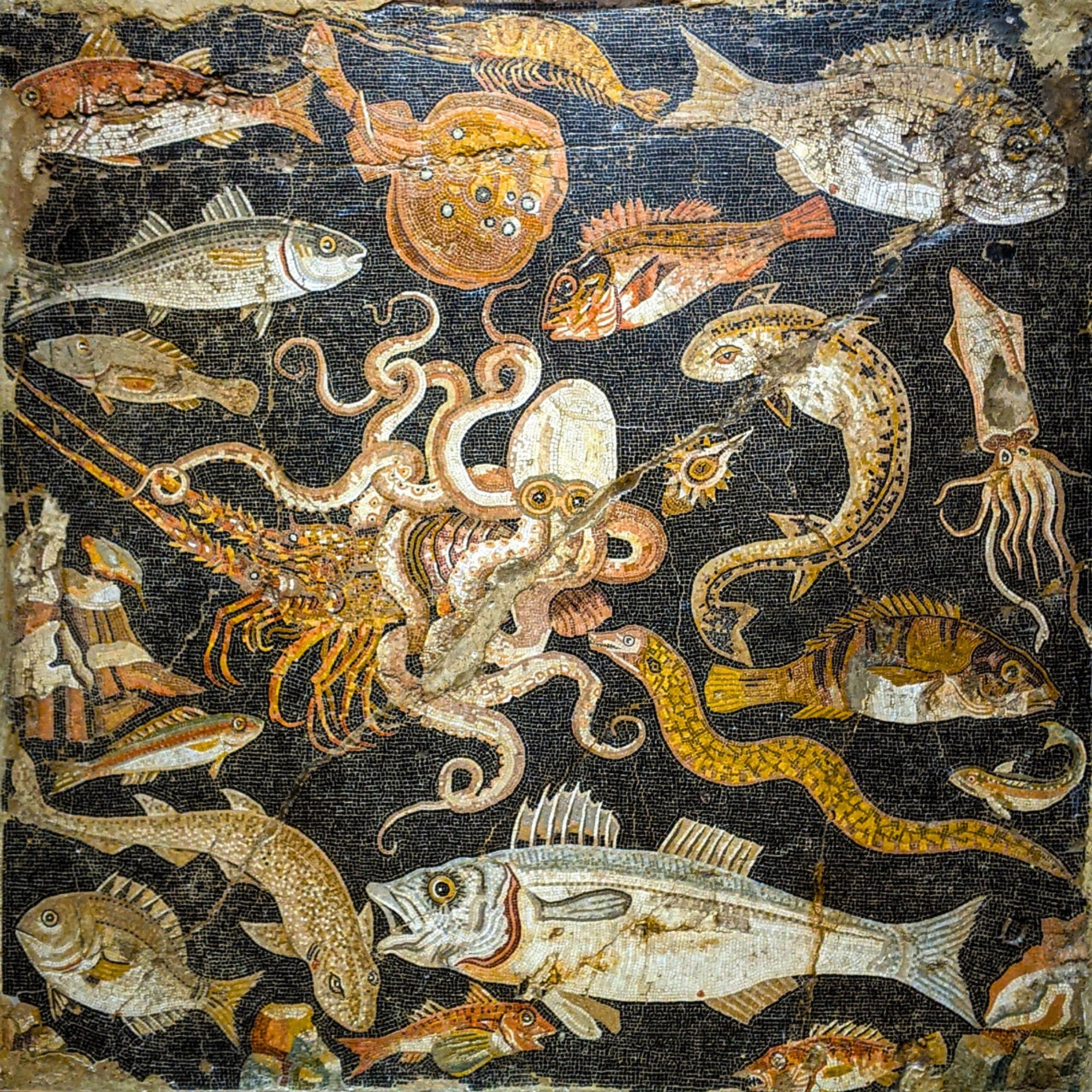
Due to its high nutritional content, including amino acids, nitrogen, and various trace elements, both garum and allec were important components in the mostly vegetarian diet of Ancient Rome.
Roman mosaic panel depicting sea life. Credits: TyB, CC BY 2.0
Garum was a liquid or semi-liquid sauce produced by allowing fish and herbs to decompose in salt. According to Pliny, it was originally made from a specific type of fish, comparable to anchovies. In contrast, common garum was created by fermenting fish entrails in salt.
Its unique taste became a staple in Roman cuisine during Apicius’ time, becoming a key ingredient in many recipes. The liquid form of garum (also known as liquamen) was so popular that it was even added to fruit preserves.
Archaeological evidence highlights the importance of this product, with production sites located along the Atlantic coasts of the Iberia and Morocco, as well as the Mediterranean and Black Sea regions. These fish processing centers, where tuna and other fish were cleaned and salted, also produced salt, and featured vats lined with cocciopesto (lime mortar mixed with crushed pottery).
In these vats, fish entrails, salt, and herbs were likely left in the sun to ferment into garum. The discovery of amphora sherds near these vats helps estimate the length of production periods. The most renowned garum, made exclusively from mackerel, was produced in Spain and sold throughout the Empire in Dressel 7-9 amphorae, according to Pliny.
North Africa also had a significant industry, producing a distinctive type of amphora for storing garum. Fragments of African amphorae used for garum trade have been found across the empire from the Severan period, indicating shifts in market trends at that time.
“Today the most popular garum is made from mackerel in the fisheries of Carthago Spartaria.
It is called sociorum, 1,000 sesterces being exchanged for about two congii of the sauce. Scarcely any other liquid except unguents has come to be more highly valued, bringing fame even to the nations that make it.
The mackerel is caught also in Mauretania and at Carteia in Baetica; the mackerel enters the Mediterranean from the Atlantic but it is only used for making garum.
Clazomenae too is famous for garum and so are Pompeii and Lepsis just as Antipolis and Thurii are for muria and indeed also Delmatia.”
Pliny the Elder


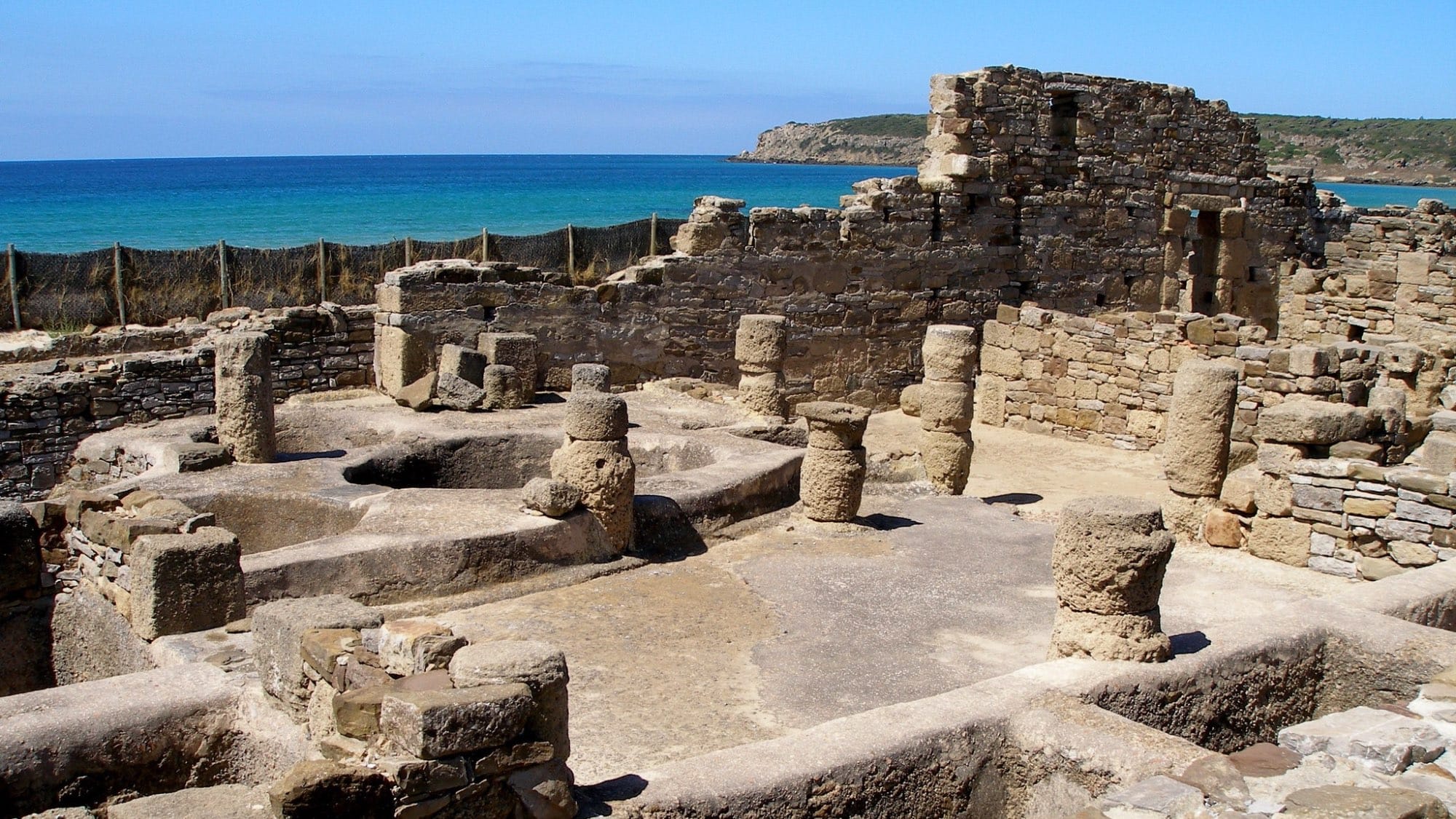
1. MUHBA, Barcelona. Credits: Joe Mabel, CC BY-SA 4.0
2. NARC Olissipo, Lisbon. Credits: Carole Raddato, CC BY-SA 2.0
3. Tarifa, Gibraltar. Credits: PhotoLanda, CC BY-NC-SA 2.0
This method of production was less common on the Tyrrhenian coast of Italy. Scholars believe this is due to the garum officina (garum factory) found in Pompeii. Although Pliny acknowledges Pompeii as a notable location for garum production, the process used there was slightly different. Instead of using vats, the ingredients were left to ferment in dolia, but the final product was still sold in amphorae like other types of garum.
An interesting detail from Diocletian’s edictum de pretiis mentions two distinct prices for first liquamen and second liquamen, likely reflecting a variation in quality.
Garum production continued in Morocco until the 5th century AD, and evidence shows that garum consumption persisted into the early medieval period and beyond. According to the Encyclopaedia Romana, traces of garum production were found as late as 1345 AD.
“Nec liquor ullus paene praeter unguenta maiore in pretio esse “
“Nor any other liquid, except perfumes, began to cost more”
Pliny the Elder
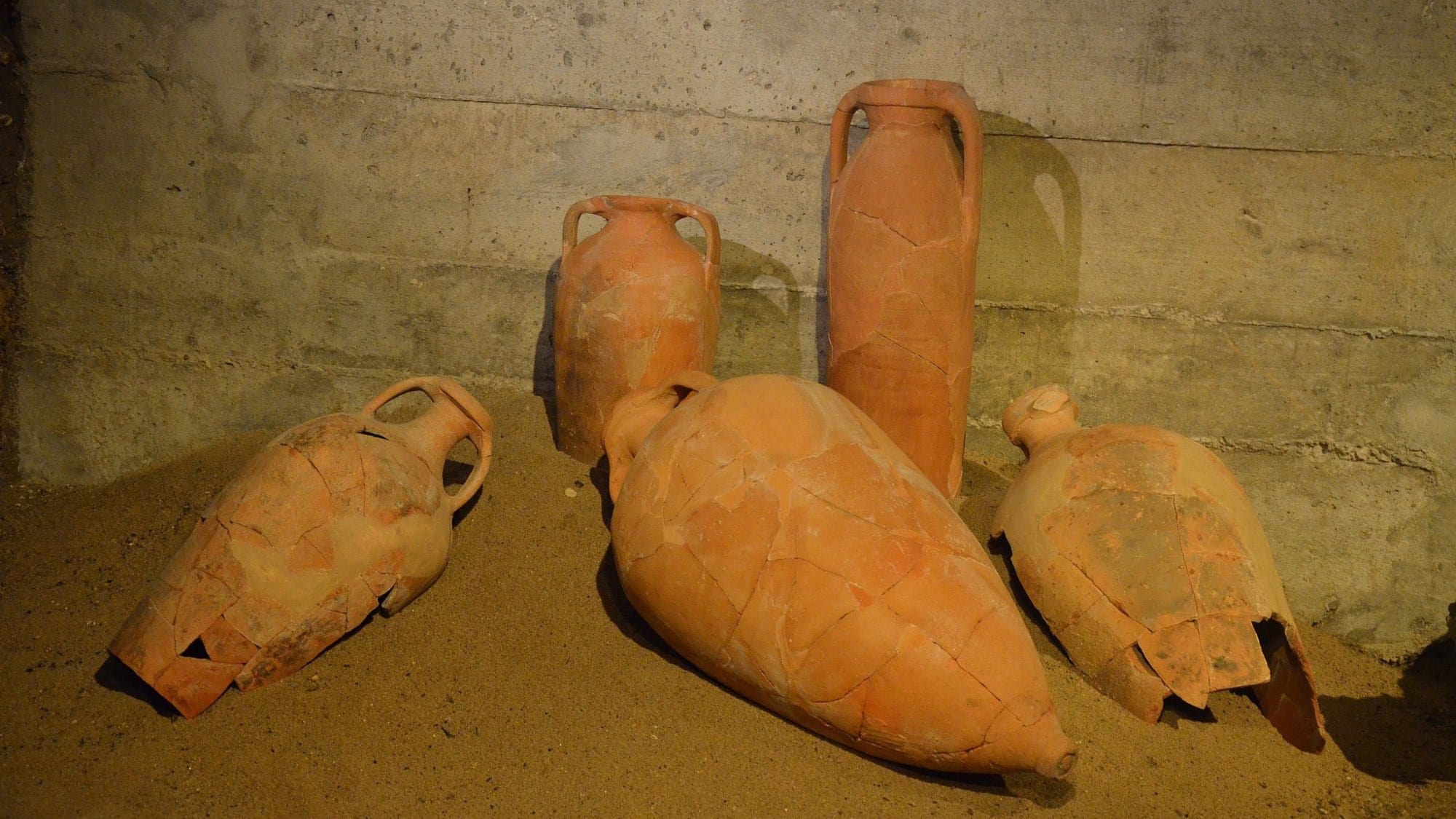
Garum: The magical remedy
Contrary to popular belief, garum was not only used as a condiment for food; it also had medicinal applications. It was specifically employed to treat ulcers and ear canal diseases.
Pedanius Dioscorides, a Greek physician and botanist from the 1st century AD during Nero’s reign, recommended garum for various ailments. He suggested it as an ointment for sores, a treatment for dog bites, and even as an oral remedy for conditions like dysentery and sciatica (as mentioned in De Materia Medica).
Petronius, also from the 1st century AD, offers an interesting depiction of garum in his work Satyricon. In the “Cena Trimalchionis,” garum is poured over fish from small wineskins.
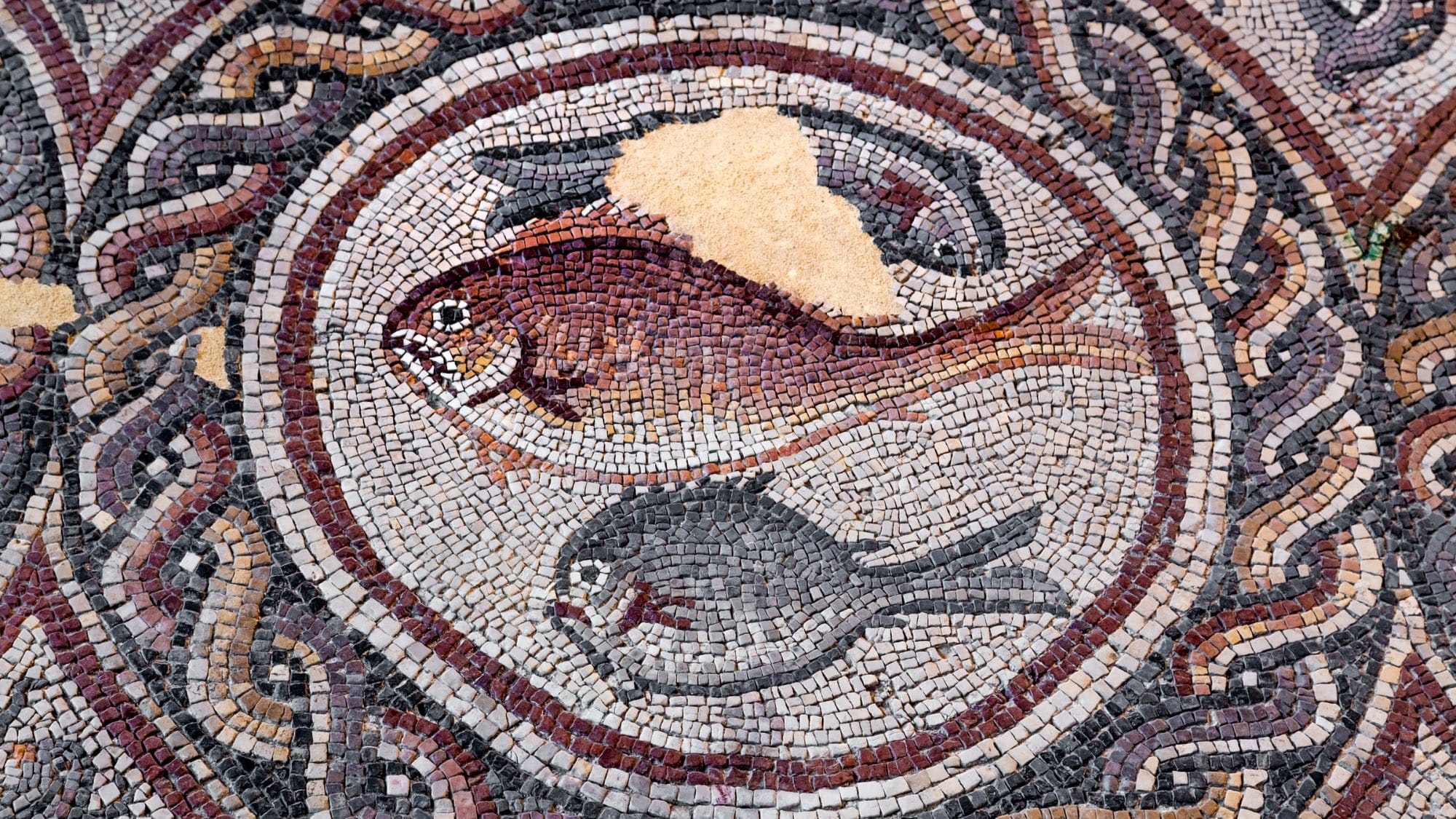
However, not all Roman writers were fans of the fish sauce.
Fish on fragment of the famous Roman Lod Mosaic. Credits: Kateryna Mashkevych from Getty Images, by Canva
As aforementioned, Seneca expressed his distaste for garum in a letter to Lucilius, the governor of Sicily at the time. Similarly, Martial criticized the strong smell of garum, humorously comparing it to the breath of Papilo, who was known for his poor hygiene.
Garum in Gastronomy
Apicius, the renowned Roman gastronome during the reign of Tiberius, authored a famous cookbook titled De re coquinaria, which has been reconstructed in Vulgar Latin, likely dating to the 3rd or 4th century AD.
In his work, Apicius emphasized the importance of seasoning, and in Book 10, he highlighted the use of fish sauce as a key condiment. He recommended garum, or liquamen as he called it, to flavor a wide range of foods, including meats, fish, vegetables, and even fruit. (Garum Sardiniae in Tabula: Rediscovering the Ancient Taste of Roman Cuisine, by Riccardo Grasso, Tania Piga, Alessio Gorga, & Manuel Mainetti)
In her book, “The story of garum, fermented fish sauce and salted fish in the ancient world,” Sally Grainger —an independent scholar with degrees in ancient history and archaeology, food historian, chef and experimental archaeologist– supports that among modern chefs and cooks, it’s well known that fish sauces have a magical ability to transform bland dishes.
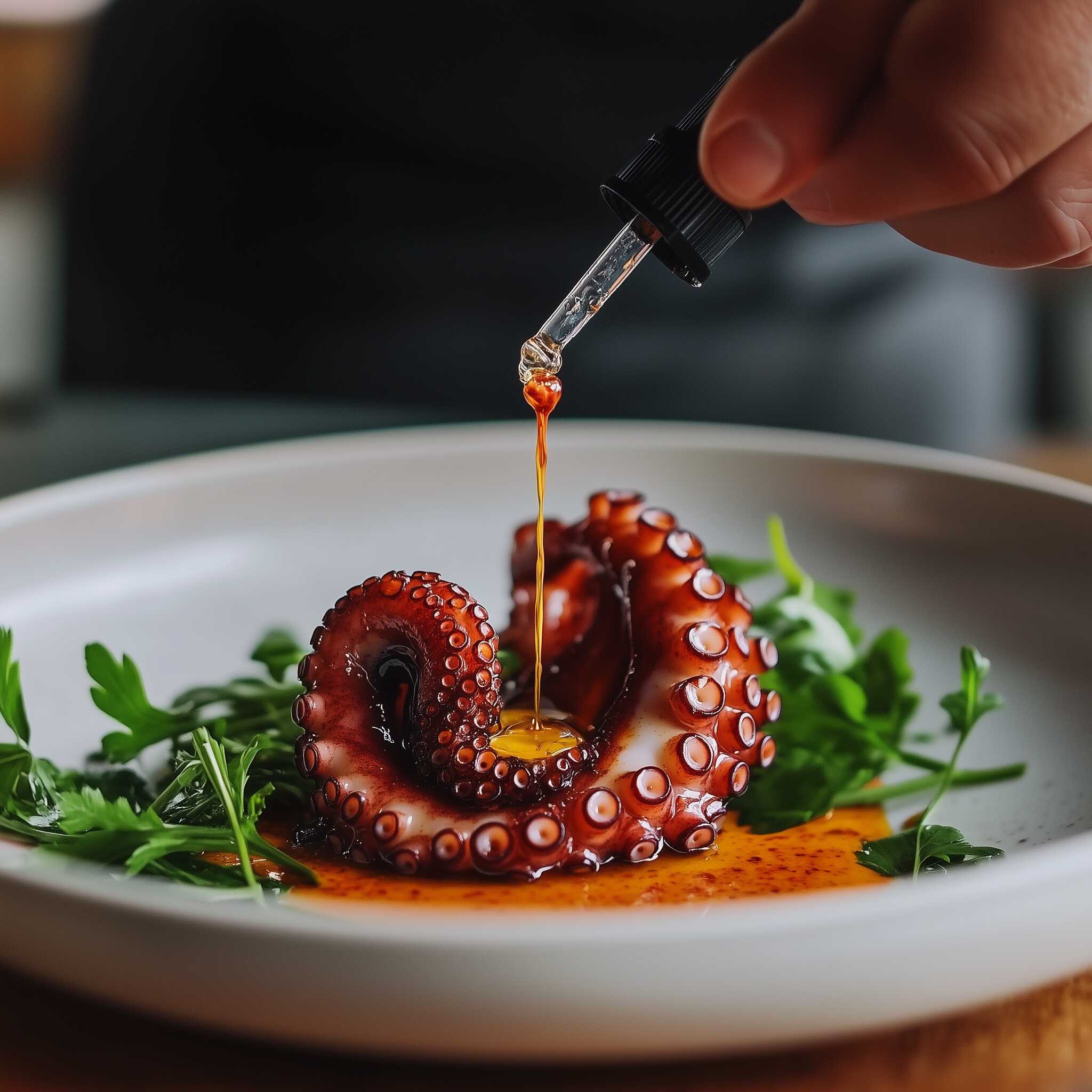
This magic is called umami, which enhances taste perception in the mouth.
Illustration: Midjourney
Monosodium glutamate (MSG), a naturally occurring compound, is found in a variety of foods like mushrooms, tomatoes, aged meat, soy sauce, parmesan, and anchovies. Glutamic acid, an excitatory neurotransmitter, excites our brains when we taste food with glutamates. In general, the more umami a food contains, the more it intensifies our perception of flavor, making the food more satisfying.
Umami also enhances other tastes, making salt saltier, sugar sweeter, and sour and bitter flavors more pleasant. This effect balances the many flavors found in ancient recipes.
Roman and Greek recipes are often criticized for their perceived overuse of spices. Modern commentators have misunderstood these multiple flavorings, especially since ancient recipes rarely specify quantities. Some spices can be sharp or acrid if used carelessly, leading to flavors that seem bitter and unbalanced.
Fish sauce, however, harmonizes these diverse flavors in a way that can only be appreciated through a “before and after” taste test. Fish sauce even works well in dishes we might consider desserts, as seen in a popular Roman dish from Apicius—a patina (frittata) made of eggs, almonds, hazelnuts, pine nuts, pepper, sweet wine, honey, milk, and fish sauce.
Sally conducted a simple taste experiment at an English heritage site with a group of young volunteers who hadn’t been too conditioned by modern tastes. They split the dish into three versions: one with fish sauce, one with a little salt, and one with no seasoning at all.
The results, were striking.
Every child who participated preferred the version with fish sauce, saying it tasted better. The flavors had become more complex, with the dominant sweetness of the eggs receding and allowing the individual flavors of the nuts, pepper, and wine to shine through. It was simply a better-tasting experience, and the children recognized this immediately.
However, some children struggled to accept that the version with fish sauce tasted better, showing how preconceived notions about fish can color perceptions. In the West, there’s often an inherent resistance to the idea of fish being a key ingredient in ancient foods. This reveals a clear divide between the perception of fish sauces as unpleasant and the reality that they are, in fact, unique products that can elevate everyday dishes.
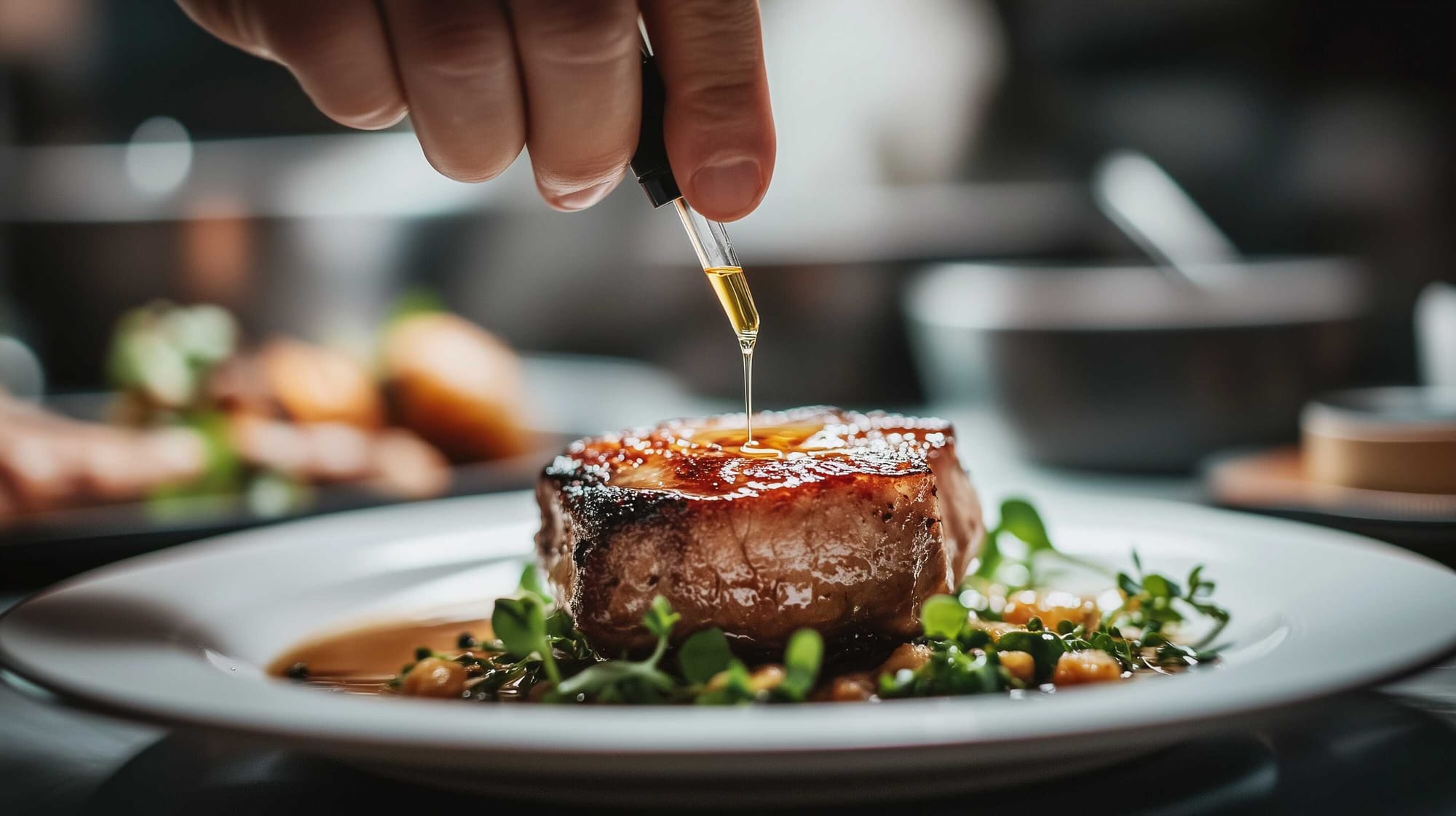
The original garum recipe — or maybe not, since we cannot be certain
Gargilius Martialis, a writer from the third century AD, in “De medicina et de virtute herbarum” writes:
“Use fatty fish, for example sardines, and a well-sealed (pitched) container with a 26-35 quart/litre capacity.
Add dried aromatic herbs possessing a strong flavour, such as dill, coriander, fennel, celery, mint, oregano, and others making a layer on the bottom of the container; then put down a layer of fish (if small leave them whole, if large use pieces); and over this add a layer of salt two fingers high.
Repeat these three layers until the container is filled.
Let it rest for seven days in the sun.
Then mix the sauce daily for twenty days.
After that time it becomes a liquid (garum)”
You can find small bottles of Lusitania garum, produced in the factories of Troia, when you visit Museu de Lisboa in Lisbon, but also in restaurants and various shops that are selling flasks or small bottles of garum. After all, Lisbon was the empire’s largest manufacturing facility and distribution center of garum to the Empire.
More specifically, garum was discovered on the island known as Ácala during the Roman era, now called Tróia, located about an hour south of Lisbon on the Sado estuary.
The region’s plentiful Atlantic fish, salt pans, and natural clay for making amphorae made it an ideal spot for garum production. In 2021, for the first time in approximately 1,600 years, garum was produced again at the ruins of Tróia, thanks to the efforts of archaeologists working on the site and two restauranteurs from Lisbon.
Victor Vicente, the owner, and Pedro Almeida, the chef of Lisbon’s Can the Can, are the masterminds behind this project. In May 2021, they placed 400 kilos of locally caught sardines (cleaned and gutted), 129 kilos of salt, and 320 liters of spring water into one of the ancient Roman stone tanks at Tróia. There, archaeologists and researchers let the ingredients ferment for six months, leading to their modern recreation of the ancient recipe.
In essence, garum can truly change your perspective of cooking, marinating and enhancing flavour. Give it a taste, and your palette will thank you.





About the Roman Empire Times
See all the latest news for the Roman Empire, ancient Roman historical facts, anecdotes from Roman Times and stories from the Empire at romanempiretimes.com. Contact our newsroom to report an update or send your story, photos and videos. Follow RET on Google News, Flipboard and subscribe here to our daily email.
Follow the Roman Empire Times on social media: